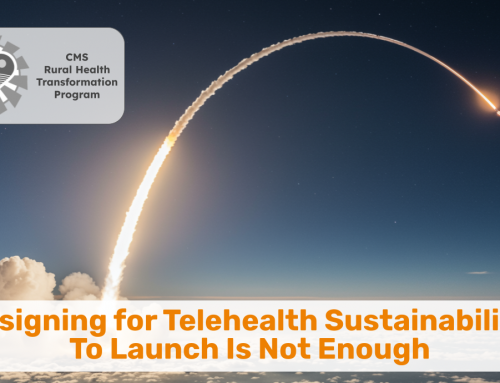At the core, any optimization of behavioral health starts with a look at opportunities to increase capacity and subsequently the utilization of that capacity. With growing behavioral health clinician shortages, each appointment slot potentially represents a critical lifeline for a patient in need.
Through a clinician-driven workflow and scheduling optimization at a rural designated behavioral health agency we were able to significantly increase the number of used appointment slots while increasing clinician satisfaction and decreasing the sense of overwhelm or feeling behind in documentation.
Leveraging video visits as an alternative care delivery modality further ensures the continuity of care by making it easier for patients to access the care more conveniently.
Dimensions of Telebehavioral Health Performance
In order to chart the course to a higher level of performance, we first need to know what “better” or “great” looks like. What are the levels of performance you are striving for?
Here is a set of common Telebehavioral Health Performance Metrics we consider in our work with behavioral health providers:
1. Improved Health Outcomes — Ultimately, we’re all after the same goal, and that is to improve the patients’ condition. Some behavioral health organizations look at “time to graduation rates” while others look at the level of psychiatric medications. While on an individual level outcomes in behavioral health can be highly subjective, by using these and other “surrogate metrics” on a larger population we are able to detect trends over time.
2. Financial Sustainability — With revenue and cost being the primary drivers of financial sustainability there are multiple strategies to pursue. While oftentimes organizations have little to no influence over reimbursement or even capitated rates, capacity and utilization are variables care providers can exert control over. On the cost side, clinician shortages have skyrocketed hiring costs driven by lengthy and costly vacancies (loss of revenue/capacity), sign on bonuses, and higher compensation, thus making a case for #4 below – high clinician satisfaction. Whether in a fee for service or a capitated environment — compensation for services is slated to go down, making it imperative to increase and utilize the fullest, sustainable capacity. (And no, I’m not going to acknowledge the ongoing limbo state of telehealth reimbursement, trusting optimistically that common sense will prevail some day.)
3. High Patient Satisfaction — while many patients may not have the choice to take their care elsewhere, achieving high patient satisfaction is key for a multitude of other reasons. First off, dissatisfaction with the way they are receiving the care distracts from the focus on the therapeutic aspect of the care. Secondly, frustrated patients create stressful experiences for clinicians, leading to burnout. Thirdly, dissatisfied patients will not graduate from their care as quickly, thus preventing others access.
4. High Clinician Satisfaction — without strong clinician support and buy-in, telebehavioral health cannot be delivered sustainably. If delivering care at a distance is too cumbersome, too complicated, too confusing, clinicians will self-adjust to minimize the use of virtual care appointments. With low clinician satisfaction it is also close to impossible to achieve high patient satisfaction, making those two measures strongly correlated.
5. High Staff Satisfaction — To deliver Telebehavioral Health well, support by scheduling and support staff is needed to ensure that the patients and the clinicians have a great experience every time. While traditionally behavioral health clinicians have taken on more than their fair share beyond the clinical work (from scheduling patients, rooming patients, and other non-clinical tasks), telebehavioral health workflows clearly benefit from distributing “what it takes” across a multitude of staff members. And if frustration among those staff run high, then this will directly impact the quality of the telehealth visit.



6. Meeting Demand through optimal capacity — While this may seem like an elusive goal, efforts must be made to increase the capacity to see more patients in a given day, week, or month. Many behavioral health agencies have waitlists that are weeks or months out even if state-mandated “first appointment” wait times have dropped. Investments into capacity improving measures – from rethinking schedules to lowering documentation burden through AI tools — are critical to ensure sustainable telebehavioral (and, simply, behavioral) health.
Turning Aspirational Performance into Action
Telebehavioral health has the potential to reshape mental healthcare delivery, breaking down geographic barriers, improving efficiency, and expanding access. However, its long-term success requires a strategic and multi-faceted approach. Organizations that embrace technology, optimize workflows, and build sustainable business models will be best positioned to lead this transformation and deliver lasting impact for patients and clinicians alike.
Stay tuned for future articles on how to turn those Performance Objectives into Key Performance Indicators and the strategies to move the needle into the right direction.
Interested in Digital Wellness and Telebehavioral Health? Then join us for free at this month’s Telehealth T-Time: A Community for Telehealth Enthusiasts on Thursday, February 20, 2025 at 11 AM and 12 PM Eastern for two presentations on “Digital Wellness Literacy: An Important Element of TeleHealth Adoption” and “From Vision to Virtual: Building Rogers Behavioral Health Telehealth Clinic”.
How is your telebehavioral health program assessing its performance? What is the strongest metric in your toolkit?








To receive articles like these in your Inbox every week, you can subscribe to Christian’s Telehealth Tuesday Newsletter.
Christian Milaster and his team optimize Telehealth Services for health systems and physician practices. Christian is the Founder and President of Ingenium Digital Health Advisors where he and his expert consortium partner with healthcare leaders to enable the delivery of extraordinary care.
Contact Christian by phone or text at 657-464-3648, via email, or video chat.






